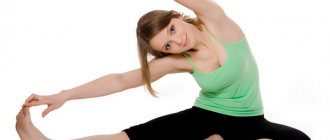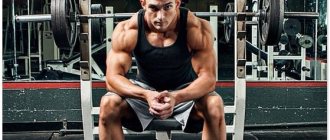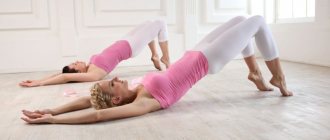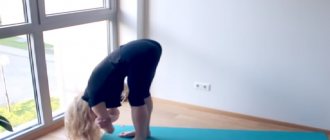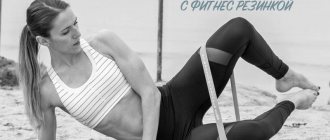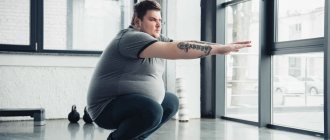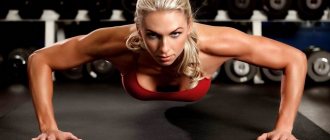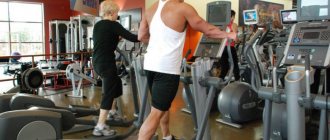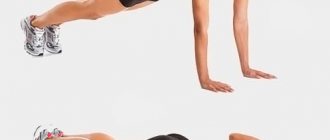Variations of walking
Each athlete is free to choose any subtype, depending on the goal.
Regular and Nordic walking are recommended for people recovering from injuries or long breaks. Also, pregnant women and elderly people can practice the exercise. To lose weight, it is advisable to choose an exercise with increased load - hill climbing, interval training, using dumbbells or a weighted belt.
The sports version is more often practiced by professional athletes who are directly involved in this sport. Or include it in the warm-up complex.
Options for walking in place for weight loss
If you decide to take your figure and health seriously, then you can buy a pedometer. This important device will help you control the weight loss process and make it easier and more enjoyable. Agree: counting exactly how much you have walked each time and keeping track of the time at the same time is very inconvenient.
You need to start with the easiest thing: on the first day, walk for 5-10 minutes at a pace convenient for you - for example, in the morning as exercise. If you feel good and energetic, repeat in the evening.
Increase this time by 5 minutes daily over the course of a week. Your task is to learn to walk for 35-40 minutes without a break without shortness of breath and fatigue. Only after this can you begin to perform more complex complexes.
How many steps does it take to lose weight?
You need to take 10,000 steps a day for weight loss to occur. This amount can be achieved not only by walking in place for weight loss. You can resort to familiar and simple methods. For example, walk up the stairs at least one flight, walk one stop, take a walk in the evening with a friend. You can simply enjoy movement and communication, and the pedometer will calculate everything for you.
Alternating
This option helps strengthen your leg muscles.
10 minutes – normal walking.
5 minutes – walking with high knees.
10 minutes - finish with slow walking.
With added steps
Here, in addition to the anterior thigh and general weight loss, the muscles of the inner and outer thighs are worked out.
10 minutes – slow walking in place.
10 minutes – side steps: take a step to the left or right, add the other leg. Then we take a step in the other direction again.
Next, we perform half squats: standing straight, take a step to the side, sit down shallowly, return the leg to its original position, repeat on the other leg.
10 minutes – slow walking.
Interval
The essence of such home fitness for women is to alternate fast speed with a slow walking pace. The values are general. You choose the number of steps that is fast and calm for you personally. The calculation is based on the number of steps per minute.
This method is one of the best for activating metabolism and starting fat burning. But you can resort to it with a healthy heart.
We walk at a speed of 50 steps per minute for 5 minutes.
Then 90 steps – 2 minutes.
Again 50 steps – 2 minutes.
90 steps – 2 minutes.
50 steps – 2 minutes.
Finally, 50 steps – 5 minutes.
After completing your home fitness routine for women, do some full-body stretching.
What else is worth knowing?
A person who walks on his hands looks much more impressive in the eyes of an outside and inexperienced observer than someone who simply stands on his hands. In fact, walking on your hands is much easier than holding a handstand, since handstands require more strength and better training of the shoulder girdle muscles to control and maintain balance.
You can learn to walk on your hands on your own, and further on we will tell you how to do this.
But first you need to remember about precautions
- In the process of performing a handstand or walking on your hands, significant loads are transferred to the shoulder, elbow and wrist joints. An awkward movement and a twisted arm can lead to injuries in the form of sprains and dislocations. Pre-strengthening the muscles of the shoulder girdle, as well as “warming them up” before training, will help reduce the likelihood of this.
- The most dangerous aspect of learning to walk on your hands is the risk of falling forward. An unsuccessful fall can lead to spinal injuries in the cervical and lumbar regions. Therefore, training should be carried out either with a partner who will insure you, or on a relatively soft surface. Beforehand, be sure to practice tipping your body forward in case of a possible fall. First, perform the usual somersaults from a sitting position, and then from a standing position on your head and hands.
- In the position of the body, when the legs are at the top and the head is at the bottom, an intense flow of blood begins to flow into it. In some cases, this may be accompanied by blurred vision, dizziness, flying stars and floaters. If you observe these symptoms in yourself, or suffer from vascular diseases of the brain, then it is better to temporarily refuse exercises in the form of walking on your hands, or at least postpone them until you consult your doctor.
Practical advice
It is recommended to begin training by strengthening the corresponding muscles. For this, simple push-ups while lying down and pull-ups on the bar are suitable for starting. Later, you can try doing push-ups while standing on your hands near a wall and resting your feet on it. When standing against a wall, your palms should be shoulder-width apart or slightly wider, and your fingers should be spread out to increase the area of support.
Try to learn how to get into this stance from a standing position facing the wall, leaning forward, placing your palms on the floor and throwing your legs towards the wall. In the future, you will use this skill to move into and out of handstand.
When you gain strength and confidence in the handstand position, you can try to start walking on them. There are two possible options here.
- Place a thick blanket or training mat 1.5 meters from the wall to cushion a possible fall. Make sure that there are no objects left on the floor in the fall zone that could cause injury.
- Walk with your back to the wall and climb into a handstand like a crab walking backwards. Bend your knees and tilt them slightly forward, slightly shifting your center of gravity. Try walking forward on your arms without bending your elbows. You must take a few steps. After them, you will find yourself in front of the mat, where you can return to your usual position on your feet. As you improve the skill of walking on your hands, the mat can be moved further and further and one day you will be able to do without it.
- Move into a handstand without a wall and try to walk on your hands. At first, ask someone to insure you against possible falls. After some training, you will be able to do without the help of an insurer.
https://youtu.be/iGAIMuqy-z8
Share this article with your friends!
What works when we walk (including standing still)?
This is how we go in everyday life - to the store, to work, for a walk in the park. At the same time, we force our body to work. What muscles are involved in the process?
If we say that the muscles of almost the entire body are involved, we are not exaggerating at all.
- The main load is received by the thigh muscles: both the back surface and the quadriceps (quadriceps) work;
- The gluteus maximus muscle also works;
- The calf muscles are also involved;
- Works the abs, biceps and triceps of the arms, deltoids;
- The core muscles act as a stabilizer.
What kind of lifestyle is considered sedentary?
Inactivity or physical inactivity is a disruption of the body's activity due to insufficient physical activity or its absence.
The problem of a sessile form of life ( the basic concept of biology is an active form of existence of matter, in a sense higher than its physical and chemical forms of existence; the totality of physical and chemical
) appeared as a result of scientific and technological progress, urbanization, and the spread of means of communication, which simplified our life and replaced active types of recreation (walks, outdoor games).
Finding out whether you lead a “moving” or a stationary lifestyle is extremely simple. If you do not move actively during the day for at least half an hour, this is considered inactive. Active movements mean walking, running, and physical exercise.
Cleaning and performing routine household chores do not count as activity. During their execution, a suitable overload is not created on the muscles of the body. While working around the house, we take incorrect postures that leave almost all muscle groups unused.
What muscles work when walking uphill or up stairs?
This exercise is basic in the health-improving physical education of most European programs. It helps maintain muscle tone, strengthens the heart and lungs, does not overload the body, and has a beneficial effect on mood. It has practically no contraindications!
Let's list what muscles are trained when walking in the Scandinavian way: muscles of the cervical-brachial region, deltas, pectoral and scapular muscles, abs. At the same time, the load is distributed evenly. The muscles of the legs and buttocks are most actively involved.
How to increase the effectiveness of your training?
- First of all, remember, the success of any sports activities is directly proportional to their regularity. Develop a program for yourself and strictly adhere to it;
- Never stop at the achieved result. Increase your training time, use weights, and include interval variations in your routine.
- Buy yourself comfortable sportswear and good sneakers;
- We recommend downloading your favorite tracks to the player and walking to the music;
- The minimum distance that should be covered per day is 5-8 km;
- Remember, your muscles are actively working while walking, so it is important to give them the opportunity to rest. Monitor the quality of your sleep and nutrition;
- Drink water and eat less salt;
- When walking on foot, the muscles become stronger if the athlete gradually increases the pace, and towards the end of the workout, gradually slows it down;
- It is advisable to exercise in the morning, especially if you are trying to lose weight;
- Try to arrange training in green parks with clean air, away from highways.
A set of exercises for older people with arthrosis of the knee joints
After a therapist diagnoses arthrosis of the knee joint, many patients believe that sports activities are now contraindicated for them. There is an opinion that physical activity will lead to a deterioration in health and cause severe pain in the knee.
Properly selected exercises for the knee joint with arthrosis significantly reduce pain and improve the course of the disease.
Sports with arthrosis of the knee joint are contraindicated during exacerbation of the disease in any form. Performing even simple exercises can cause sharp pain in the knee joint and provoke soft tissue ruptures.
Also, patients with a severe form of the disease are not recommended to engage in strenuous sports, for example, running or doing squats. Exercises for arthrosis of the knee joint of the first and second degrees also have some contraindications.
Exercise machines for knee arthrosis can only be used after a doctor’s permission. In this case, you can only exercise on such simulators that place minimal stress on the knee.
Walking with arthrosis
Walking at a moderate pace is indicated for any form of the disease. Walking for half an hour a day will help stretch the knee joint and improve blood circulation.
In addition, while walking, the body muscles are kept in good shape, forcing the joint to work, which prevents it from stiffening.
Longer walks for patients with arthrosis are not recommended, since excessive stress on the joint will lead to complications of the disease. In order for walking to be beneficial in the treatment of osteoarthritis, the following rules should be followed:
- you need to choose comfortable low-top shoes with wide soles;
- the duration of the walk should not exceed 30-40 minutes; as you get used to it, the time can be gradually increased;
- You need to walk no more than 2 km per day;
- While walking, you should not carry any weights - bags or backpacks.
Following the rules will allow you to get only benefits from walking. Walking with arthrosis of the knee joint is contraindicated for people with heavy weight, as this puts a lot of stress on the legs.
In addition to regular walking, you can pay attention to its other varieties.
Thanks to the correct placement of the foot during movement, as well as special devices, there is a beneficial effect on the knee.
Running with arthrosis
Many people are concerned about whether it is possible to run with arthrosis of the knee joint. Doctors say that with osteoarthritis of the second and higher degrees, running is contraindicated. At the initial stage of development of the disease, jogging is allowed after consulting a doctor.
Patients will also have to refrain from playing sports that include running. Such sports activities include:
- football;
- basketball;
- tennis;
- hockey;
- figure skating.
If the doctor, after a comprehensive examination, allows the patient to jog, it is still necessary to monitor his health. So, if the patient feels pain while running, the exercise should be stopped immediately. It is better to start running short distances.
Swimming with arthrosis of the knee joint is the very sport that will not only not be harmful, but will also help overcome the disease.
In addition, exercises in water will help relieve pain and relax muscles. Therefore, patients with osteoarthritis are recommended to regularly visit the pool or swim in open water.
In addition to swimming in the pool, doing various exercises is also beneficial. For example, you can walk along the bottom of the pool, do leg swings, and stretching exercises.
Bicycles for arthrosis of the knee joint are strictly contraindicated. The surface on which you walk may be uneven, as a result of which the knee may be injured. Instead, you can use an exercise bike for arthrosis of the knee joint.
When choosing an exercise bike, you need to pay attention to the degree of resistance of the pedals - they should be pressed gently so as not to put additional stress on the knee.
The best option is to perform the “bicycle” exercise. To do this, you need to lie on your back, raise your legs 30 cm from the floor and perform circular movements with them, which imitate riding a bicycle. Thus, thanks to smooth translational movements, the joint warms up.
READ MORE: Leg below knee swells and hurts
Yoga is an ideal sport for patients suffering from osteoarthritis. All exercises are performed smoothly, and any load on the joint is completely eliminated. At the same time, the knee is not immobilized, which improves blood flow to it.
According to yogic teachings, arthrosis is caused by accumulation of energy. Therefore, performing basic asanas involves normalizing energy flows in the human body. You can see an example of exercises for the knees in the video.
Therefore, yoga for arthrosis of the knee joint can be used at any stage of the disease.
conclusions
Thus, arthrosis of the knee joint is not an obstacle to playing sports, but the choice of exercises must be approached with special care. It is important not to overload the knee, but to limit yourself to performing measured exercises.
Before choosing a sport, it is better to consult with your doctor, who, based on the degree of the disease, will help you choose a training program. Choosing the right exercises can significantly improve your health.
Benefits of walking
So, we have found out which muscle groups work when walking on foot in its different variations. As you understand, this exercise helps strengthen muscle tone and increase the athlete’s endurance. What else is useful?
- The cardiovascular and respiratory systems are strengthened;
- Mood improves, stress goes away, hormonal and metabolic processes normalize;
- Coordination of movements improves;
- Ligaments, joints and tendons are strengthened;
- Posture improves.
Walk, a lot and for a long time. Do not underestimate this exercise; just remember which muscle groups are affected by walking, and it will become clear to you that it is useful, no less than running. Meanwhile, the latter has many more contraindications. Do not give up sports, even if for medical reasons it is prohibited to you. Find a moderate form of exercise - walk in the park every day or try Nordic walking. Remember, movement is life!
Potential harm and contraindications
Excessive or monotonous load on unprepared, weakened muscles can cause harm when walking. So start with the minimum, even just kneeling for a few minutes.
Contraindications include any knee injuries.
In order not to harm your health, you need to perform the exercise correctly. The principle here is very clear - it is simply walking on all fours or on your knees in an upright position. However, there are several variations of the exercise and recommendations for its implementation.
How not to harm yourself when doing the exercise:
- If it hurts to go down and kneel, let them get used to it first. Kneel on the pillows and just stand there for as long as you can stand it. The next step is to remove the pillows and start moving. In the first days, take at least two or three steps, and add the same amount every day. The “golden ratio,” according to doctors, is 400 steps a day.
- It is extremely important to practice daily. Below we will describe the healing effect this exercise produces on the body as a whole and its individual organs and systems. But remember: it only comes with daily exercise!
- If you walk on the floor, have a blanket, mat or soft carpet under your feet. You can wear gloves on your hands and knee pads on your feet. And, for example, professor, doctor of medical sciences Sergei Bubnovsky recommends wrapping bags filled with crushed ice to your knees. But over time, you won't need them anymore.
- About the direction of movement. You need to start by walking forward, then back - and again in turn. The torso is in a strictly vertical position, without stooping or bending left or right. If you walk on all fours, take steps as wide as possible. For variety, you can walk in a circle, square, figure eight, sideways with side steps, write letters with your feet, go up and down stairs, and use the Nordic walking technique with ski poles.
- After completing the exercises, lie on your back, lift straight but relaxed arms and legs and shake them, relieving tension from worked muscles and joints.
Neither age, nor lack of physical fitness, nor financial costs will become obstacles to performing Taoist health exercises. The main thing is your desire. Work on yourself a little - and soon you will forget where your knees are, and moving through life will become much easier.
